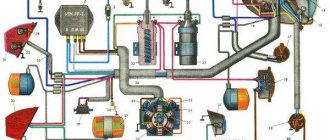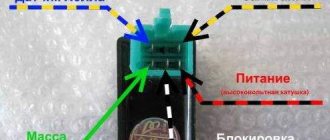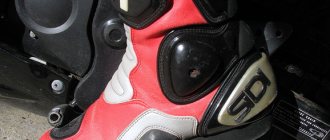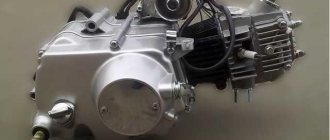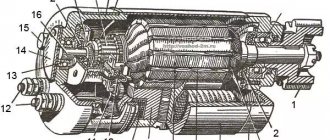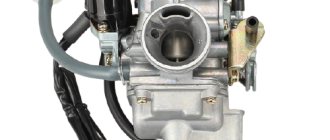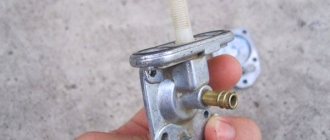Catalog
Category: Rechargeable batteries
In gel (not helium) batteries there is no gas - helium; in them the electrolyte is bound by a solid material and thickened, that is, it is in a gel state. Therefore, without fear of depressurization, a maintenance-free battery can be opened if it is impossible to charge it and the voltage on it drops below 10 V.
The first is pouring distilled water into the battery jars
Although gel batteries are also called dry batteries, they must contain a water-based electrolyte inside them. And water in gel, and especially in acid, batteries is a consumable material, since when it is reduced by electrolysis of lead sulfate deposits on the plates, it is destroyed into the hydroxyl group and hydrogen. The latter leaves any battery into the surrounding air. In gel batteries, hydrogen escapes through rubber valve caps located under the outer plastic cover, which is often covered. Therefore, a very dry gel battery that has lost capacity needs to be topped up with distilled water .
To service a “maintenance-free” battery, you will need to tear off the glued top cover and remove all valve caps. You need to add a little water - not to the edges of the filler necks on the jars. The poured water will be absorbed into the filter paper, so after half an hour, look (by shining a flashlight) to see how much water is left in each section of the battery. The water level should slightly cover the surface of the battery plates, so excess liquid will have to be removed with a syringe or rubber bulb.
Extreme method: cyclic “running” of a gel battery
Some car enthusiasts ask how to restore a gel battery with high voltage and whether it can be done at all. This method has always existed. But if you decide to use it right away, you need to keep in mind that it will either work or it won’t. However, with great desire and caution, you can try.
The first charging cycles are usually carried out with high voltage, the minimum is 30 V, and when the battery “swings” and begins to consume current, the voltage is gradually reduced to the traditional 14 V. The battery should be discharged gently between cycles, using a light bulb with a power of 5-10 W will be quite enough.
After such a “buildup”, you can charge the battery in the usual mode, with a current equal to 10% of its rated capacity, measured in ampere-hours (Ah). For example, if a battery has a capacity of 70 Ah with an output voltage of 12 V, 7 A is the current with which it needs to be charged.
Recovery by long-term charging
After moistening the dried electrolyte, close all battery jars with valve caps. And also do not forget to cover them with the outer battery cover, and press it down with a weight (glue it later). You need to press down on the lid so that it holds the rubber caps. When charging, excess pressure created by the released hydrogen will be released through the caps, and the lid will act as a stop for them.
Now it's time to connect the damaged gel battery to the charger . Learn how to charge a maintenance-free battery . Having lost capacity due to drying of the bound electrolyte, the battery will not consume current from the charger , so there is no need to first rely on the ammeter. The charging voltage must be at least 15 V.
It will take a long time to charge - until the starved battery begins to consume current. But if more than 15 hours have passed and the battery does not consume current, then do not expect a miracle, but increase the voltage to 20 V. Now do not leave a battery charging at high voltage unattended. After all, if the bound electrolyte is restored, then an abnormally high current will flow through the battery, which will be 4–6 times higher than expected. A current even 4 times greater than the maximum permissible 0.1 of the capacity will heat up the battery, then smoke will come out of it, and then...
The moment the battery begins to accept current, the voltage across it will begin to drop quickly.
Motorcycle Battery Restoration
Do you know that when you buy a battery of an unknown brand, it can last much less than your old branded battery that you restored with your own hands?
To restore a motorcycle battery you will need:
- Distilled water
- Electrolyte nominal density
- A device for measuring the density of electrolyte is called a hydrometer. By the way, you are restoring a motorcycle battery, so you need to find a hydrometer that is not large.
- Charger with adjustable current
- Electrolyte additive - desulfating
Possible causes of battery failure:
When charging in one of the sections, the electrolyte immediately boils - there is a high probability of shorting the plates. In this case, you should not try to charge the battery; you can try rinsing the jar with distilled water. You need to wait until the coal crumbs stop washing out of the jar. After this, we bring the required density in the battery and put it on charge. It won’t help - you can safely throw away the battery, there’s nothing you can do with a closed battery, you can mechanically close the plates, but only in road conditions - to get home on a motorcycle.
The battery capacity has dropped noticeably (down to zero) - there is a high probability that the battery plates are sulfated. In this case, a desulfating additive to the electrolyte will help us.
Usually, the technology for cleaning the battery plates is included in the instructions for this additive, the general points from it are as follows: Filling the battery with electrolyte with a nominal density of 1.28 g/cm 3 Add an additive to each jar; some additives can be added to the electrolyte before filling it into the battery. We wait a couple of days until the additive dissolves in the electrolyte and run the battery through the so-called charge-discharge cycle. It consists of the following: we charge and immediately discharge the battery; we discharge it, of course, not with the motorcycle starter, but for example with a brake light bulb. Discharging continues until the battery voltage reaches approximately ten volts. The cycle must be repeated until the electrolyte density in the battery is equal to the nominal one - 1.28 g/cm3
General recommendations for motorcycle battery maintenance
- Monitor the density and level of electrolyte.
- A cold garage is not the best place to store a battery during the off-season.
- If your charger does not have smooth adjustment of the charging current, such a charger is not suitable for a motorcycle battery. The charging current of a motorcycle battery should be 0.1 of its capacity in ampere-hours.
- Back
- Forward
Cyclic charging
A good way to “rock” a battery that doesn’t want to charge is to first let the battery charge and then discharge it – and so on alternately, in short periods. The first charging cycles, specifically for a gel battery, should occur at high voltage - about 30 V, and in subsequent cycles the charging voltage should be gradually reduced to 14 V.
You need to discharge a recharged battery with a very small load - a 5 or 10 W light bulb, and not a car carrier with 50, 75 or 100 W light bulbs. But even when unloading the battery using a small light bulb, monitor the voltage on the battery so that it does not drop below 10.5 V.
After you have managed to force the “emaciated” battery to swallow current, continue to restore it to full charge by long-term charging with a low current - equal to 0.05 of the battery capacity.
The restoration of acid batteries follows a completely different algorithm.
Author: Vitaly Petrovich, Ukraine, Lisichansk.
Methods for restoring a motorcycle battery
To restore a motorcycle battery you will need: - a charger with the ability to adjust the current;
- aerometer - a device that measures the density of the electrolyte;
— desulfating additive in the electrolyte;
- electrolyte with nominal density.
- Some battery malfunctions.
- In one of the sections, the electrolyte boils during charging.
This fault is caused by shorted plates. In these cases, you do not need to charge the battery again; you should rinse the jar with distilled water until coal chips stop leaching out of it.
After this, the density is brought to the desired parameter, and the battery is charged again. If the procedures do not help, you can throw away this battery without hesitation; nothing can be done about such a closed battery. In road conditions, you can try to directly close the plates to get to the service station.
- The battery capacity has dropped to zero.
In such cases, there is a high probability of plates becoming sulfated. To eliminate this, you should use a desulfating additive.
As usual, the technology for cleaning plates is described in the instructions for the additive. General points:
— electrolyte (density 1.28 g/cm3) is poured into a jar;
- add an additive to each of the cans;
— wait 2-3 days for the scale to dissolve;
— “chase” the battery through charge/discharge cycles
“Overclocking” is done like this: we charge it, and then immediately discharge it (preferably with a light bulb) until the voltage drops by 10 V.
The cycle is repeated until the nominal density reaches 1.28 g/cm3.
When a person brings a motorcycle out of winter hibernation, the very first thing, of course, you want to start the engine in this motorcycle. If you did the right thing - removing the battery from.
For every vehicle owner, sooner or later there comes a time when he is faced with the need to sell a vehicle. There may be cases.
Before storing your motorcycle in the garage for the winter, wash it thoroughly and place it on its side stand on a comfortable, stable, flat surface. As for.
The engineers who created the BMW G450X motorcycle did their best. They managed to create an almost ideal “car” that behaves both on asphalt and off-road.
Due to the small mirrors and the body and elbows blocking the visible area, the rider must constantly turn his head in all directions to have good control around him.
How to restore a motorcycle battery?
To restore a motorcycle battery we will need: 1) distilled liquid; 2) Electrolyte with nominal density. 3) A device to measure the density of the electrolyte itself, it is called a hydrometer. By the way, you are renewing a motorcycle battery, and therefore, you need to find a small hydrometer. 3) Charging with voltage regulation. 4) Electrolyte additive, also known as desulfating additive. Possible breakdowns and breakdowns of rechargeable batteries: When fully charged in one part, the electrolyte instantly boils, there is a very high possibility of shorting the plates. In this case, do not try to revive the battery; you need to try washing the jar with distilled water. You need to keep trying until the coal crumbs are washed away from the wall of the can.
Next, find the required battery density, then connect the charger to it. If this does not help, you can take and throw away the battery, with a battery that is shorted, in which case nothing can be done, you can, of course, mechanically try to close the jumpers, if you are just on the road, this will help you get on a motorcycle to your home. If the battery capacity has dropped significantly (almost to zero), this means that there is a high probability of sulfation of the plates. In such a situation, a desulfating electrolyte additive will help here.
Traditionally, the technology for cleaning battery plates is in the instructions with this additive; the general parts of it look like this: Filling into an electrolyte battery with a nominal density of 1.28 grams per cubic centimeter. We add additives to all jars; you can add certain additives to the electrolyte before pouring it into the battery. We wait for several days until the additive is corroded by the electrolyte. And we “torment” the battery along the charge-discharge chain.
Related materials:
- Advantages and disadvantages of gel car batteries The main difference between gel batteries and conventional starter acid batteries is the thickened state of the electrolyte. Adding...
- What to do to make the engine last a long time A car engine can be called the heart of any car. Without it it is impossible to start moving. If the engine has some breakdowns...
- Using contract spare parts when preparing a car for spring The off-season for a motorist is a time for preventative measures. After frosty weather, slippery, snowy roads, not all cars end up in...
- The use of ignition coils, different brands, and a vibrator in car repair. The car uses a non-contact ignition system with a transistor switch TK-200 (TK-200-01) and an ignition coil 6-118. Usage …
- BOSCH batteries – high quality and affordable price Batteries produced under the BOSCH brand are an excellent choice for every car enthusiast. They combine reliability, durability,…


